check engine Alfa Romeo Giulietta 2014 User Guide
[x] Cancel search | Manufacturer: ALFA ROMEO, Model Year: 2014, Model line: Giulietta, Model: Alfa Romeo Giulietta 2014Pages: 280, PDF Size: 6.65 MB
Page 124 of 280

Warning lights on
panelWhat it means What to do
amberINJECTION/EOBD SYSTEM FAILURE
In normal conditions, when the ignition key is turned to
MAR-ON the warning light switches on, but should
switch off as soon as the engine is started.
The operation of
warning light may be checked by
the traffic police using specific devices. Comply with the
laws and regulations of the country where you are
driving.
13)
If the warning light remains on or switches on whilst
driving, it means that the injection system is not working
properly. In particular, the warning light on constantly
signals a malfunction in the injection/ignition system
which could cause high exhaust emissions, a possible
loss of performance, poor driveability and high
consumption.
On some versions, the display shows the dedicated
message.
The warning light goes out after the fault disappears: the
indication is stored in the system.Under these conditions, you may continue
travelling at a moderate speed without
demanding excessive effort from the
engine. Prolonged use of the car with the
warning light on constantly may cause
damage.
Contact an Alfa Romeo Dealership as
soon as possible.
Petrol engines only
If the warning light flashes, it means that the catalytic
converter may be damaged.In this case, it is necessary to release the
accelerator pedal to lower the speed of
the engine until the warning light stops
flashing. Continue the journey at moderate
speed, trying to avoid driving conditions
that may cause further flashing and
contact an Alfa Romeo Dealership as
soon as possible.
120
KNOWING THE INSTRUMENT PANEL
Page 126 of 280
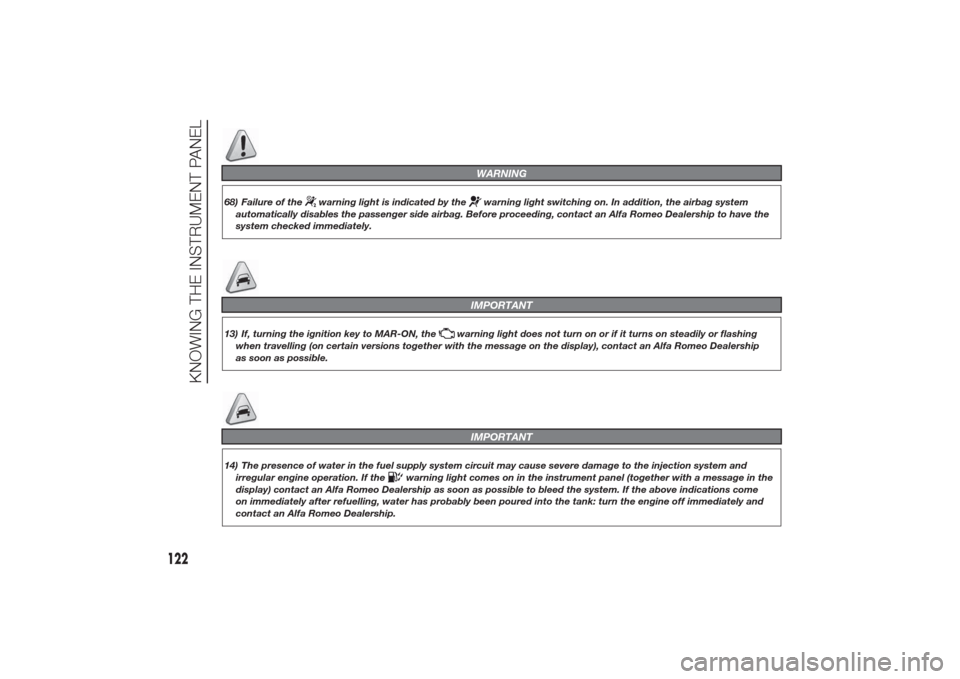
WARNING
68) Failure of the
warning light is indicated by the
warning light switching on. In addition, the airbag system
automatically disables the passenger side airbag. Before proceeding, contact an Alfa Romeo Dealership to have the
system checked immediately.
IMPORTANT
13) If, turning the ignition key to MAR-ON, the
warning light does not turn on or if it turns on steadily or flashing
when travelling (on certain versions together with the message on the display), contact an Alfa Romeo Dealership
as soon as possible.
IMPORTANT
14) The presence of water in the fuel supply system circuit may cause severe damage to the injection system and
irregular engine operation. If the
warning light comes on in the instrument panel (together with a message in the
display) contact an Alfa Romeo Dealership as soon as possible to bleed the system. If the above indications come
on immediately after refuelling, water has probably been poured into the tank: turn the engine off immediately and
contact an Alfa Romeo Dealership.
122
KNOWING THE INSTRUMENT PANEL
Page 167 of 280
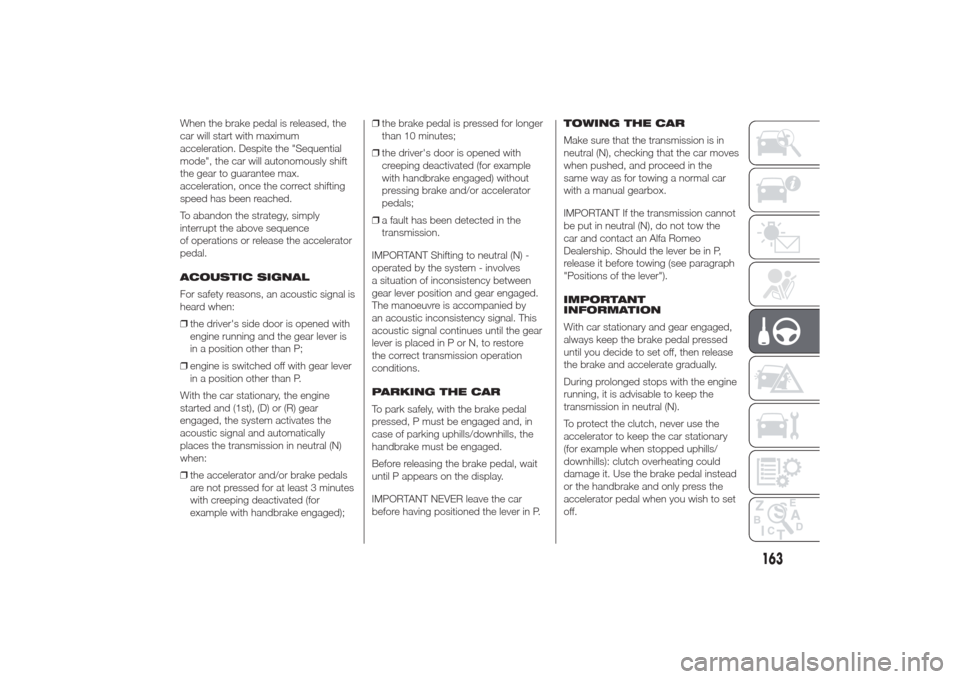
When the brake pedal is released, the
car will start with maximum
acceleration. Despite the "Sequential
mode", the car will autonomously shift
the gear to guarantee max.
acceleration, once the correct shifting
speed has been reached.
To abandon the strategy, simply
interrupt the above sequence
of operations or release the accelerator
pedal.
ACOUSTIC SIGNAL
For safety reasons, an acoustic signal is
heard when:
❒the driver's side door is opened with
engine running and the gear lever is
in a position other than P;
❒engine is switched off with gear lever
in a position other than P.
With the car stationary, the engine
started and (1st), (D) or (R) gear
engaged, the system activates the
acoustic signal and automatically
places the transmission in neutral (N)
when:
❒the accelerator and/or brake pedals
are not pressed for at least 3 minutes
with creeping deactivated (for
example with handbrake engaged);❒the brake pedal is pressed for longer
than 10 minutes;
❒the driver's door is opened with
creeping deactivated (for example
with handbrake engaged) without
pressing brake and/or accelerator
pedals;
❒a fault has been detected in the
transmission.
IMPORTANT Shifting to neutral (N) -
operated by the system - involves
a situation of inconsistency between
gear lever position and gear engaged.
The manoeuvre is accompanied by
an acoustic inconsistency signal. This
acoustic signal continues until the gear
lever is placed in P or N, to restore
the correct transmission operation
conditions.
PARKING THE CAR
To park safely, with the brake pedal
pressed, P must be engaged and, in
case of parking uphills/downhills, the
handbrake must be engaged.
Before releasing the brake pedal, wait
until P appears on the display.
IMPORTANT NEVER leave the car
before having positioned the lever in P.TOWING THE CAR
Make sure that the transmission is in
neutral (N), checking that the car moves
when pushed, and proceed in the
same way as for towing a normal car
with a manual gearbox.
IMPORTANT If the transmission cannot
be put in neutral (N), do not tow the
car and contact an Alfa Romeo
Dealership. Should the lever be in P,
release it before towing (see paragraph
"Positions of the lever").
IMPORTANT
INFORMATION
With car stationary and gear engaged,
always keep the brake pedal pressed
until you decide to set off, then release
the brake and accelerate gradually.
During prolonged stops with the engine
running, it is advisable to keep the
transmission in neutral (N).
To protect the clutch, never use the
accelerator to keep the car stationary
(for example when stopped uphills/
downhills): clutch overheating could
damage it. Use the brake pedal instead
or the handbrake and only press the
accelerator pedal when you wish to set
off.
163
Page 168 of 280
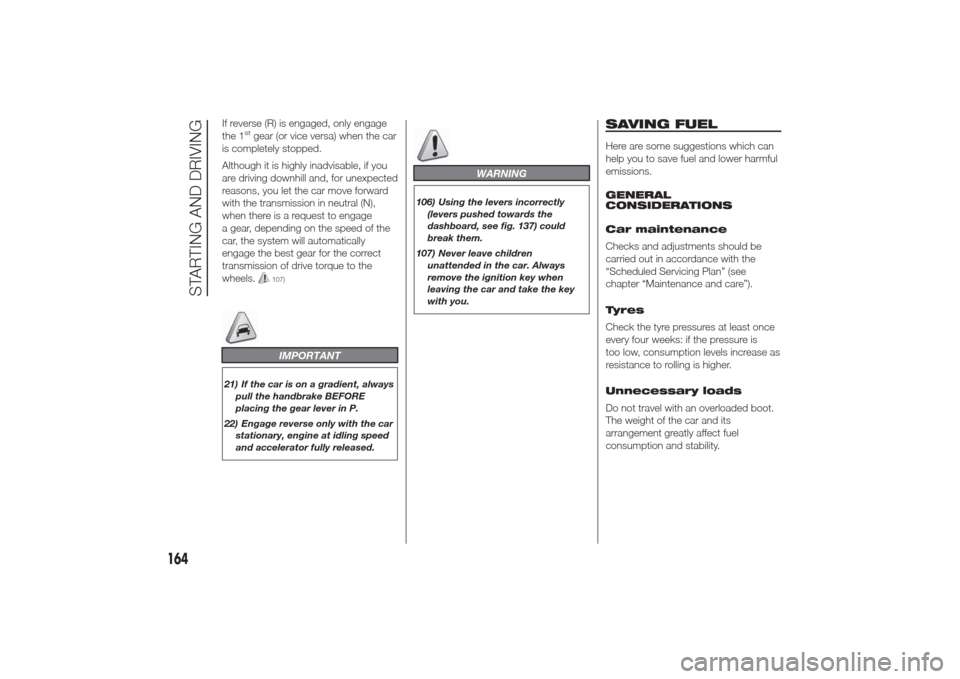
If reverse (R) is engaged, only engage
the 1
stgear (or vice versa) when the car
is completely stopped.
Although it is highly inadvisable, if you
are driving downhill and, for unexpected
reasons, you let the car move forward
with the transmission in neutral (N),
when there is a request to engage
a gear, depending on the speed of the
car, the system will automatically
engage the best gear for the correct
transmission of drive torque to the
wheels.
107)IMPORTANT
21) If the car is on a gradient, always
pull the handbrake BEFORE
placing the gear lever in P.
22) Engage reverse only with the car
stationary, engine at idling speed
and accelerator fully released.
WARNING
106) Using the levers incorrectly
(levers pushed towards the
dashboard, see fig. 137) could
break them.
107) Never leave children
unattended in the car. Always
remove the ignition key when
leaving the car and take the key
with you.
SAVING FUELHere are some suggestions which can
help you to save fuel and lower harmful
emissions.
GENERAL
CONSIDERATIONS
Car maintenance
Checks and adjustments should be
carried out in accordance with the
“Scheduled Servicing Plan” (see
chapter “Maintenance and care”).
Tyres
Check the tyre pressures at least once
every four weeks: if the pressure is
too low, consumption levels increase as
resistance to rolling is higher.
Unnecessary loads
Do not travel with an overloaded boot.
The weight of the car and its
arrangement greatly affect fuel
consumption and stability.
164
STARTING AND DRIVING
Page 172 of 280
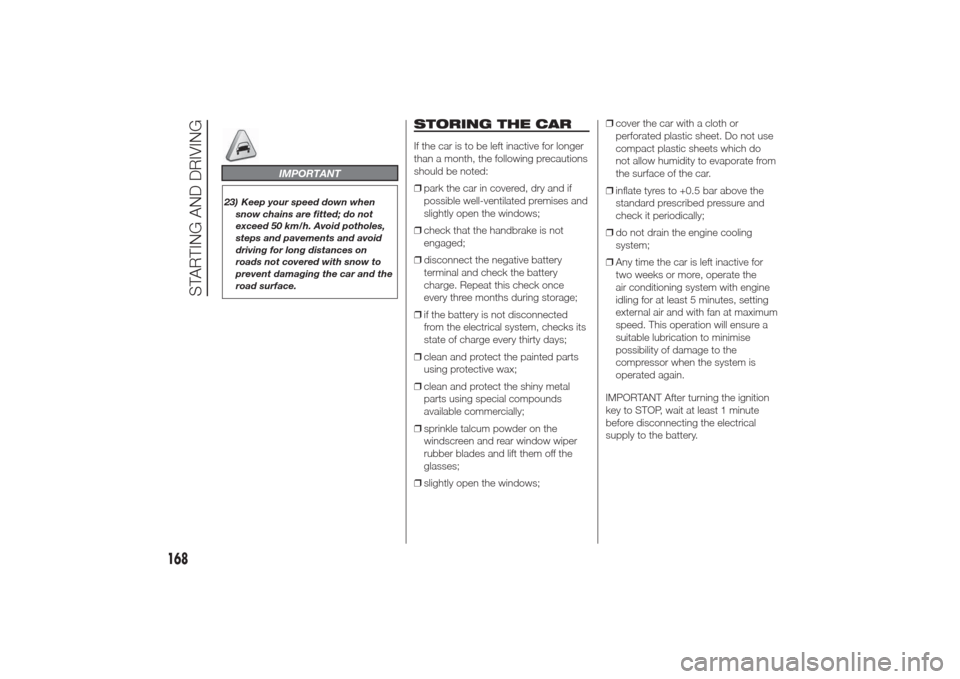
IMPORTANT
23) Keep your speed down when
snow chains are fitted; do not
exceed 50 km/h. Avoid potholes,
steps and pavements and avoid
driving for long distances on
roads not covered with snow to
prevent damaging the car and the
road surface.
STORING THE CARIf the car is to be left inactive for longer
than a month, the following precautions
should be noted:
❒park the car in covered, dry and if
possible well-ventilated premises and
slightly open the windows;
❒check that the handbrake is not
engaged;
❒disconnect the negative battery
terminal and check the battery
charge. Repeat this check once
every three months during storage;
❒if the battery is not disconnected
from the electrical system, checks its
state of charge every thirty days;
❒clean and protect the painted parts
using protective wax;
❒clean and protect the shiny metal
parts using special compounds
available commercially;
❒sprinkle talcum powder on the
windscreen and rear window wiper
rubber blades and lift them off the
glasses;
❒slightly open the windows;❒cover the car with a cloth or
perforated plastic sheet. Do not use
compact plastic sheets which do
not allow humidity to evaporate from
the surface of the car.
❒inflate tyres to +0.5 bar above the
standard prescribed pressure and
check it periodically;
❒do not drain the engine cooling
system;
❒Any time the car is left inactive for
two weeks or more, operate the
air conditioning system with engine
idling for at least 5 minutes, setting
external air and with fan at maximum
speed. This operation will ensure a
suitable lubrication to minimise
possibility of damage to the
compressor when the system is
operated again.
IMPORTANT After turning the ignition
key to STOP, wait at least 1 minute
before disconnecting the electrical
supply to the battery.
168
STARTING AND DRIVING
Page 181 of 280

❒inflate the tyre to the pressure
indicated in the “Wheels” paragraph
in the “Technical data” chapter. In
order to obtain a more precise
reading, check the pressure value on
pressure gauge B fig. 153 with the
compressor off;
❒if after five minutes it is still impossible
to reach at least 1.8 bar, disengage
the compressor from the valve and
power socket, then move the car
forwards by approx. ten metres
in order to distribute the sealing fluid
inside the tyre evenly, then repeat
the inflation operation;
❒if you still cannot obtain a pressure of
at least 1.8 bar within 5 minutes from
the compressor switching on, do
not drive off and contact an Alfa
Romeo Dealership;❒after having driven for about 10
minutes, stop and recheck the tyre
pressure; remember to engage
the handbrake;
❒if a pressure value of at least 1.8 bar
is detected, restore the correct
pressure (with the engine running and
the handbrake engaged), resume
driving and drive with great care to an
Alfa Romeo Dealership.
CHECKING AND
RESTORING TYRE
PRESSURE
The compressor can also be used to
check and, if necessary, adjust the tyre
pressure.
Release quick coupling A fig. 157 and
connect it directly to the valve of the
tyre to be inflated.
152
A0K0518
153
A0K0519
154
A0K0520
155
A0K0128
156
A0K0521
177
Page 205 of 280

SCHEDULED SERVICING PLAN1.4 Turbo Petrol and 1.4 Turbo MultiAir VERSIONSThousands of miles 18 36 54 72 90 108
Thousands of kilometres 30 60 90 120 150 180
Months24 48 72 96 120 144Check tyre conditions/wear and adjust pressure, if required●●●●●●
Check operation of lighting system (headlamps, direction indicators, hazard warning
lights, passenger compartment, luggage compartment, instrument panel warning
lights, etc.)●●●●●●
Check operation of windscreen washer/wiper system●●●●●●
Check the position/wear of the windscreen/rear window wiper blades●●●●●●
Check condition and wear of front disc brake pads and operation of pad wear
indicator●●●●●●
Check rear disc brake pad condition and wear●●●●●●
Condition and status visual check: bodywork exterior, underbody protection, pipes
and hoses (exhaust - fuel system - brakes), rubber elements (boots - sleeves -
bushes etc.)●●●●●●
Check cleanliness of bonnet and boot locks, as well as cleanliness and lubrication of
linkages●●●●●●
Check and, if necessary, top up fluid levels (engine cooling, hydraulic brakes/clutch,
screen washer, battery, etc.)●●●●●●
Check handbrake lever travel and adjust, if required●●●●●●
Check timing belt condition●●
201
Page 206 of 280
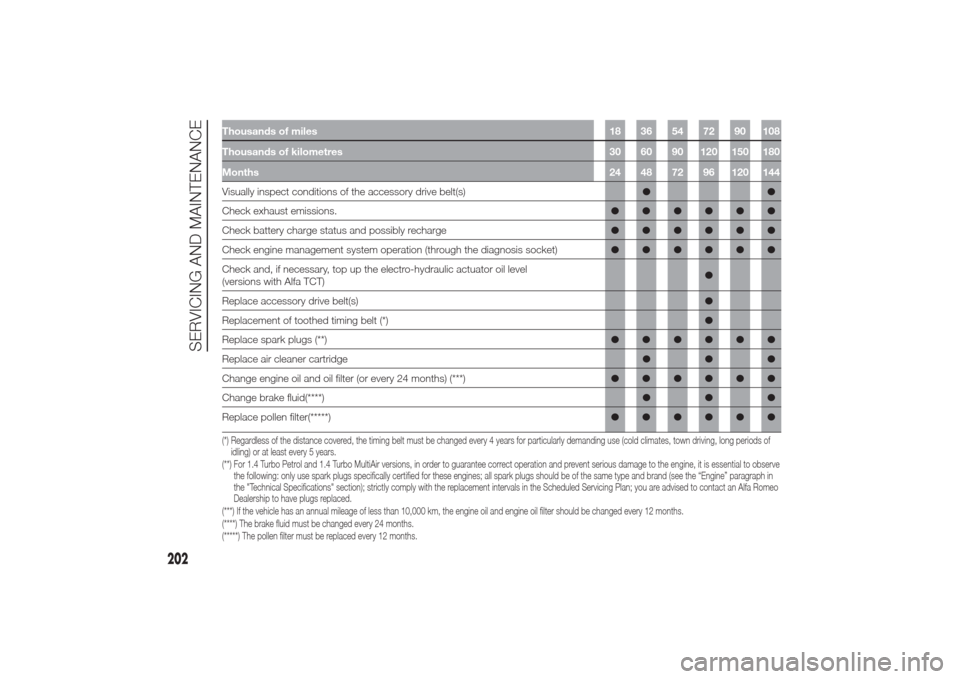
Thousands of miles 18 36 54 72 90 108
Thousands of kilometres 30 60 90 120 150 180
Months24 48 72 96 120 144Visually inspect conditions of the accessory drive belt(s)●●
Check exhaust emissions.●●●●●●
Check battery charge status and possibly recharge●●●●●●
Check engine management system operation (through the diagnosis socket)●●●●●●
Check and, if necessary, top up the electro-hydraulic actuator oil level
(versions with Alfa TCT)●
Replace accessory drive belt(s)●
Replacement of toothed timing belt (*)●
Replace spark plugs (**)●●●●●●
Replace air cleaner cartridge●●●
Change engine oil and oil filter (or every 24 months) (***)●●●●●●
Change brake fluid(****)●●●
Replace pollen filter(*****)●●●●●●(*) Regardless of the distance covered, the timing belt must be changed every 4 years for particularly demanding use (cold climates, town driving, long periods of
idling) or at least every 5 years.
(**) For 1.4 Turbo Petrol and 1.4 Turbo MultiAir versions, in order to guarantee correct operation and prevent serious damage to the engine, it is essential to observe
the following: only use spark plugs specifically certified for these engines; all spark plugs should be of the same type and brand (see the “Engine” paragraph in
the "Technical Specifications" section); strictly comply with the replacement intervals in the Scheduled Servicing Plan; you are advised to contact an Alfa Romeo
Dealership to have plugs replaced.
(***) If the vehicle has an annual mileage of less than 10,000 km, the engine oil and engine oil filter should be changed every 12 months.
(****) The brake fluid must be changed every 24 months.
(*****) The pollen filter must be replaced every 12 months.
202
SERVICING AND MAINTENANCE
Page 207 of 280
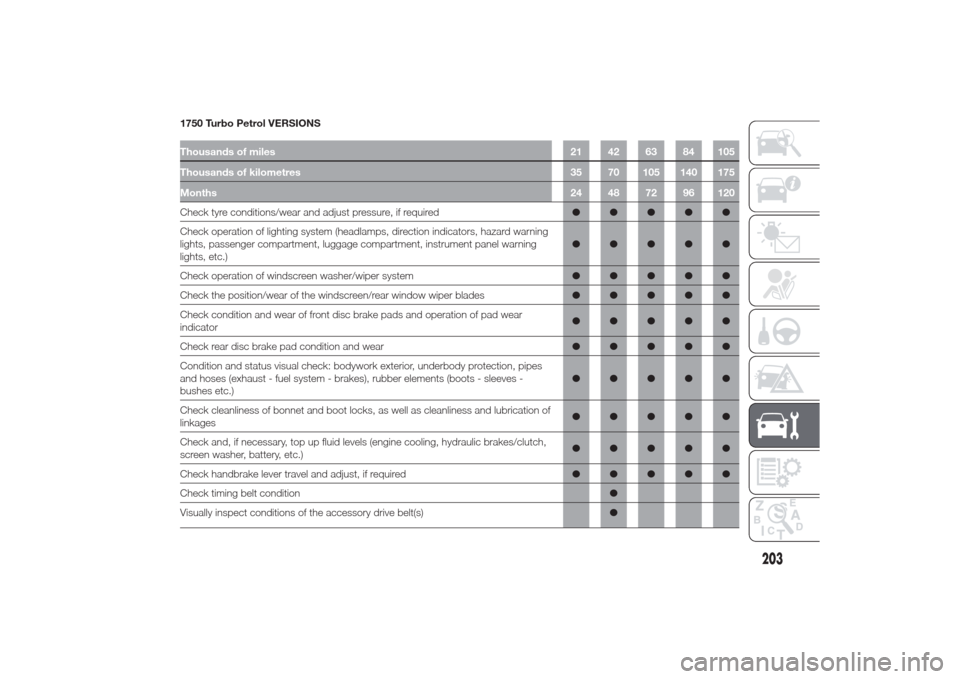
1750 Turbo Petrol VERSIONSThousands of miles 21 42 63 84 105
Thousands of kilometres 35 70 105 140 175
Months24 48 72 96 120Check tyre conditions/wear and adjust pressure, if required●●●●●
Check operation of lighting system (headlamps, direction indicators, hazard warning
lights, passenger compartment, luggage compartment, instrument panel warning
lights, etc.)●●●●●
Check operation of windscreen washer/wiper system●●●●●
Check the position/wear of the windscreen/rear window wiper blades●●●●●
Check condition and wear of front disc brake pads and operation of pad wear
indicator●●●●●
Check rear disc brake pad condition and wear●●●●●
Condition and status visual check: bodywork exterior, underbody protection, pipes
and hoses (exhaust - fuel system - brakes), rubber elements (boots - sleeves -
bushes etc.)●●●●●
Check cleanliness of bonnet and boot locks, as well as cleanliness and lubrication of
linkages●●●●●
Check and, if necessary, top up fluid levels (engine cooling, hydraulic brakes/clutch,
screen washer, battery, etc.)●●●●●
Check handbrake lever travel and adjust, if required●●●●●
Check timing belt condition●
Visually inspect conditions of the accessory drive belt(s)●
203
Page 208 of 280

Thousands of miles 21 42 63 84 105
Thousands of kilometres 35 70 105 140 175
Months24 48 72 96 120Check exhaust emissions.●●●●●
Check battery charge status and possibly recharge●●●●●
Check engine management system operation (through the diagnosis socket)●●●●●
Replace accessory drive belt(s)●
Replacement of toothed timing belt (*)●
Replace spark plugs●●
Replace air cleaner cartridge●●
Change engine oil and replace oil filter (**)
Change brake fluid(***)●●
Replace pollen filter(****)●●●●●(*) Regardless of the distance covered, the timing belt must be changed every 4 years for particularly demanding use (cold climates, town driving, long periods of
idling) or at least every 5 years.
(**) The actual interval for changing the oil and replacing the engine oil filter depends on the car usage conditions, it is signalled by the warning light or message (for
versions/markets, where provided) in the instrument panel and must never exceed 12 months.
(***) The brake fluid must be changed every 24 months.
(****) The pollen filter must be replaced every 12 months.
204
SERVICING AND MAINTENANCE